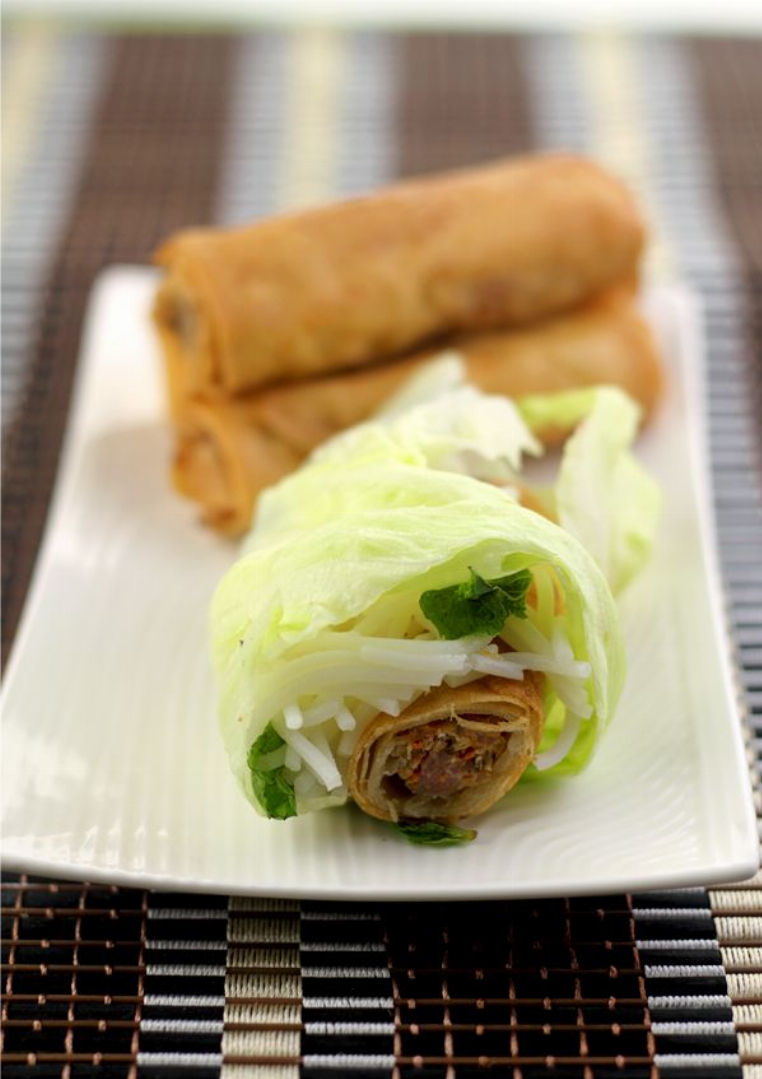We’re only a week away from Tết, the Asian New Year. And of course, food is what makes the festivities so much fun. Eggrolls (chả giò) are Maman’s must-have dish for the celebration. My favorite version is chicken eggrolls. I usually use dark meat (chicken thighs and legs), which make the dish more moist and flavorful. I also mix in fried jicama and carrots for added crunch.
Preparing them isn’t that complicated; they’re labor-intensive, but if you have a large crew of little helpers as I do, rolling them is a piece of cake. All you need to do next is deep-fry them and enjoy them wrapped in lettuce along with rice noodles.
1. Info for Chicken Eggrolls (Cha Gio Recipe)
- Cook Time: 30 min
- Total Time: 45 min
- Servings: 8
- Calories: 157 kcal
2. Ingredients for Chicken Eggrolls (Cha Gio Recipe)
- 1-½ pounds ground chicken (see tips), freshly ground
- ½ cup canola oil (or any neutral oil), as needed
- 1 tablespoon freshly grated ginger
- ½ teaspoon salt
- 4 fresh wood ear mushrooms, thinly sliced
- ½ jicama (see tips)
- ¼ cup leeks (green part only)
- 1 carrot, shredded
- 1 (2-ounce) package dried bean thread noodles
- 4 tablespoons fried yellow onions (see tips)
- 1 teaspoon mushroom seasoning salt (or regular salt)
- 2 tablespoons cilantro, chopped
- 1 teaspoon black pepper, freshly ground
- 2 packages frozen eggroll wrappers
3. Directions:
- Prepping the chicken: In a large bowl, combine the ground chicken, fried onions, leeks and ginger. Season with salt and pepper. Cover with plastic wrap and refrigerate for at least 2 hours. For the dried bean thread noodles: Place the whole package of dried bean thread noodles in a bowl. Don’t forget to cut the little threads and discard them! Soak the noodles in cold water for 30-40 minutes (up to 1 hour, depending on the brand), then drain. Chop into 1 inch threads. Set aside. For the jicama: Peel and slice horizontally into ½-inch thick pieces. In a large pan, heat the oil and fry the jicama slices until golden brown. Once they are cool enough to handle, cut the pieces into very thin strips, then finely chop them. Set aside. Making eggroll filling: Add carrots, jicama, bean thread noodles, wood ear mushrooms and cilantro to the chicken mixture. Sprinkle with mushroom powder. Mix well. Refrigerate the mixture until you’re ready to wrap the eggrolls. Key for proper seasoning: In a small pan, heat about 1 teaspoon of oil. Add about 1 tablespoon of the chicken mixture. Cook for about 3 minutes. Taste the meat. Season with more salt and pepper if necessary. Get a bowl filled with cold water ready. Cut the eggroll wrappers into 2 triangles and separate them. They’re sold in packages of 30 squares that are stuck together. Place about 2-3 teaspoons of the eggroll filling at the base of the triangle. Moisten one of the corners and fold it along the base towards the other corner along the base so that it just covers the filling. Then roll the wrapper once towards the top corner. Repeat with the other corner that is along the base. Moisten the exposed top corner with water using your finger, then finish rolling. Once a plate is full of uncooked eggrolls, you can either cover with plastic wrap and store them in the refrigerator overnight or in the freezer for up to a month. Once you’re ready to cook them, fill a large frying pan with any neutral oil about 2 inches high. Make sure your pan is tall enough so that there is enough room to add the eggrolls without the oil overflowing. Place the eggrolls in the hot oil one at a time, seam side down. You will see bubbles. As soon as each eggroll turns slightly golden, rotate it. When the eggrolls are even and golden all the way around, remove from the pan and place on a paper towel to drain the oil. They should be golden, crispy and delicious. You can serve them as appetizers or a main course. Wrap the eggrolls in lettuce with cooked thin rice vermicelli noodles (called bún) and Vietnamese mint. Serve with a dipping sauce (fermented fish sauce base called nước mắm) and Sriracha.

